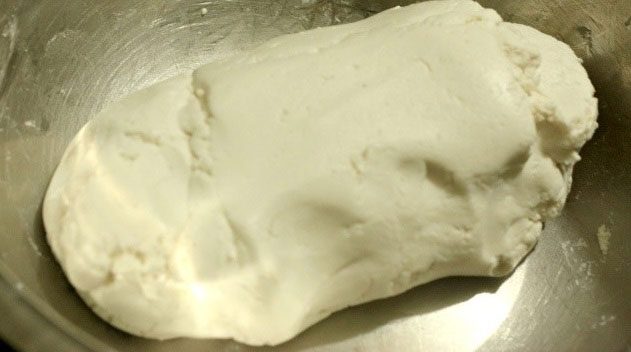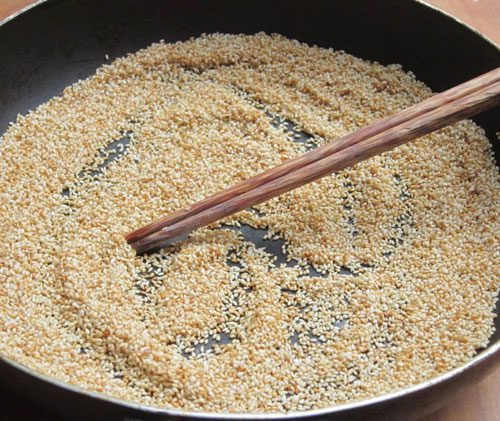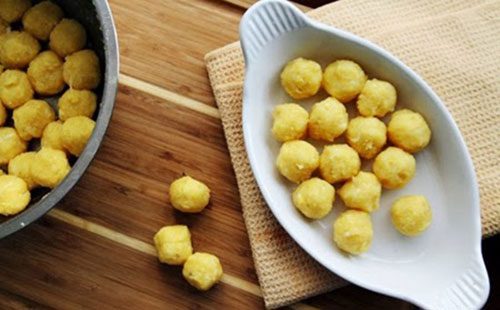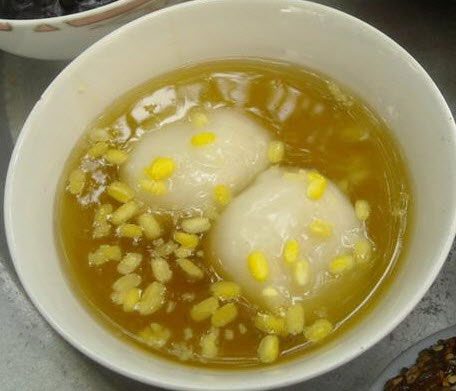On the Cold Food Festival (Tết Hàn thực), celebrated on the 3rd day of the 3rd lunar month, every family is busy preparing plates of glutinous rice cakes (bánh trôi) and plain rice cakes (bánh chay). However, not everyone is aware of the origins and significance of this festival.
Understanding the Cold Food Festival
- Origin of the Cold Food Festival on the 3rd of the 3rd lunar month
- The significance of glutinous rice cakes and plain rice cakes during the Cold Food Festival for the Vietnamese
- Is the Cold Food Festival a Vietnamese or Chinese tradition?
- How does the Cold Food Festival in Vietnam differ from that in China?
- Prayers for the Cold Food Festival
- Offerings for the Cold Food Festival
- How to make glutinous rice cakes and plain rice cakes for the Cold Food Festival
Origin of the Cold Food Festival on the 3rd of the 3rd lunar month
In Chinese, “Hàn” means cold, and “thực” means food, so “Tết Hàn thực” translates to “Cold Food Festival.” This ancient tradition originates from China and is based on a captivating story passed down through generations. The tale recounts that during the Spring and Autumn period (770 – 221 BC), King Wen of the State of Jin, faced with turmoil, fled his kingdom and lived in exile in the states of Qi and Song. At that time, a wise man named Jie Zituo assisted the king with many strategies. One day, while fleeing, Jie Zituo ran out of food and secretly cut a piece of his own thigh to cook for the king. After eating, the king discovered what had happened and was deeply moved.
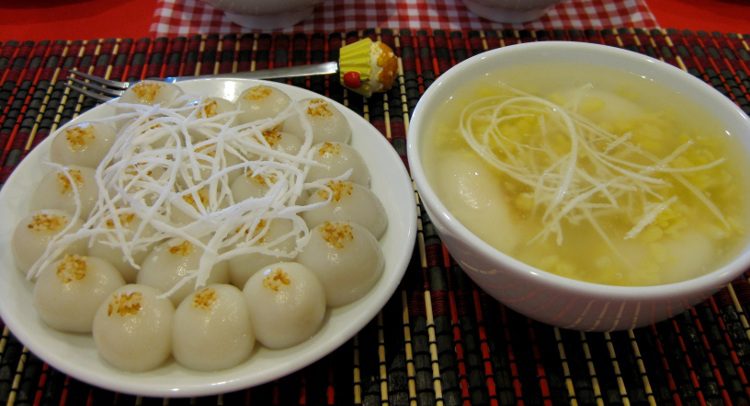
The Cold Food Festival is celebrated on the 3rd of the 3rd lunar month and has its origins in China.
Jie Zituo served King Wen for nineteen years, enduring hardships together and honing his skills. Later, when King Wen reclaimed his throne, he generously rewarded those who accompanied him, but he forgot Jie Zituo. Jie Zituo bore no resentment, believing it was his duty to serve the king, and felt that it was not worth mentioning.
Therefore, he returned home and took his mother to hide in the Dian Mountain. King Wen eventually remembered him and sent people to find Jie Zituo. However, Jie Zituo, being indifferent to fame, refused to return for his reward. King Wen ordered the forest to be burned to force Jie Zituo to come back. Unexpectedly, Jie Zituo was resolute, and both he and his mother perished in the fire.
The king regretted this and established a temple in their honor. Every year on the 3rd of the 3rd month, which marks the death of Jie Zituo and his mother, cooking is forbidden, and even offerings must be prepared the day before; this is regarded as the Cold Food Festival.
The significance of glutinous rice cakes and plain rice cakes during the Cold Food Festival for the Vietnamese
Although originating from China, the Cold Food Festival for the Vietnamese has its own unique characteristics, deeply rooted in Vietnamese culture.
This occasion allows the Vietnamese to honor their roots and remember the virtues of their ancestors. On this day, the Vietnamese do not avoid fire and continue to cook as usual. Notably, the Vietnamese have creatively made glutinous rice cakes and plain rice cakes, which are cold foods symbolizing the Cold Food Festival.
Every year on the 3rd of the 3rd lunar month, people eat cooked food that is allowed to cool as a sincere act of remembrance for the nurturing care of their departed loved ones.
Unlike the Cold Food Festival in China, on this day, the Vietnamese do not avoid fire and continue cooking as usual. The unique aspect is that the Vietnamese have created glutinous rice cakes and plain rice cakes as symbolic cold foods.
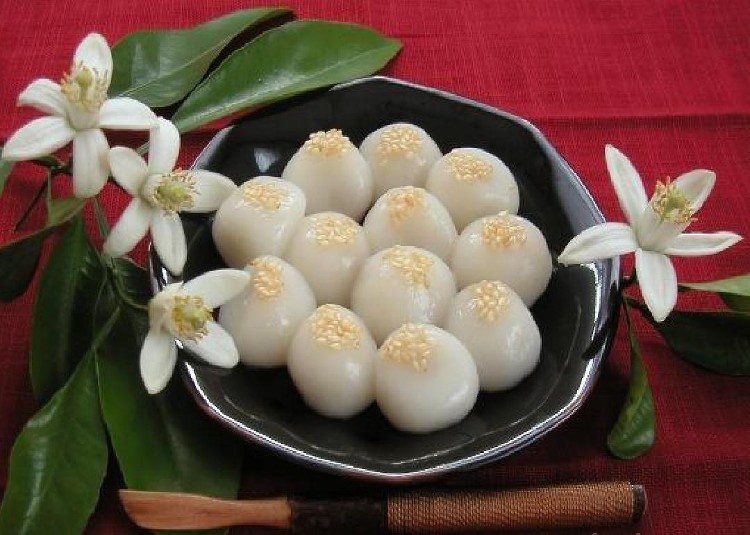
Glutinous rice cakes.
The custom of eating rice rolls: Alongside glutinous rice cakes and plain rice cakes, rice rolls are also a traditional dish during the Cold Food Festival. Historical records suggest that the custom of eating rice rolls on this festival may have originated during the Tran Dynasty and continues to be passed down to this day.
Honoring ancestral roots
The Cold Food Festival for the Vietnamese primarily signifies honoring ancestral roots and remembering the contributions of those who have passed away. For instance, the Vietnamese have a custom of offering glutinous rice cakes to the spirits of the Trung Sisters on the 6th of the 3rd month in Ha Tay. Following this, on the death anniversary of the Hung Kings on the 10th of the 3rd month, Vietnamese people from all over the country gather at the Hung Temple in Phu Tho to light incense and offer plates of glutinous rice cakes and plain rice cakes to honor their roots… Thus, it is evident that our Cold Food Festival reflects a unique ethnic identity, enduring through the nation-building and defense process.
Cultural traditions
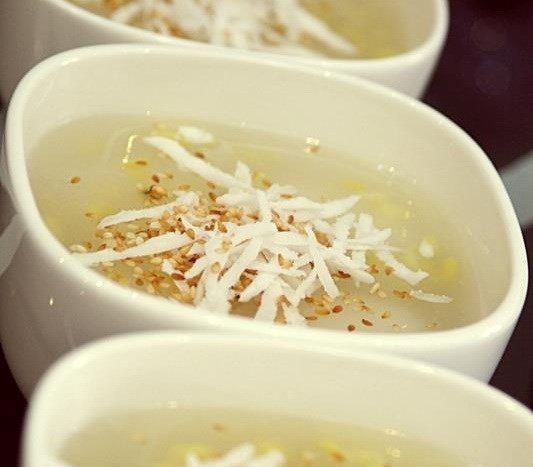
Plain rice cakes.
Glutinous rice cakes and plain rice cakes are the highlights of this festival. Since ancient times, these cakes have become part of the national poetry as popular traditional dishes among the Vietnamese. Both types of cakes are made from fragrant glutinous rice flour. Glutinous rice cakes are shaped into small balls, white on the outside with a red sugar filling, and boiled until they float to the surface. Plain rice cakes are flattened into round shapes, without filling, placed on small dishes, and served with sweet syrup.
Recalling ancient tales
During these days, enjoying a plate of glutinous rice cakes and plain rice cakes with loved ones allows us to feel the warmth of human relationships. Many people also share that eating glutinous rice cakes and plain rice cakes on this day serves to reminisce about ancient stories, about a distant past of our nation.
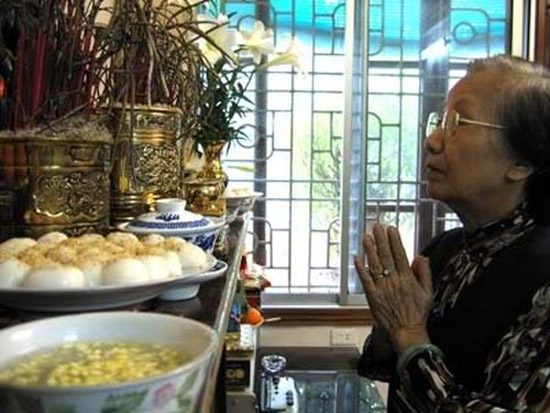
The Cold Food Festival with traditional glutinous rice cakes and plain rice cakes is an occasion for everyone to remember the nurturing care of those who have passed away.
There is also a legend that glutinous rice cakes and plain rice cakes originated during the era of the Hung Kings, and the custom of making these two types of cakes recalls the tale of “the hundred eggs” of Au Co. The hundred small cakes symbolize the hundred eggs of Lac Long Quan. Glutinous rice cakes represent the 50 eggs that hatched into 50 children who followed their mother into the mountains. Plain rice cakes represent the 50 eggs that hatched into 50 children who followed their father to the sea.
These traditions have deeply embedded themselves in the consciousness of the Vietnamese people, so that every Cold Food Festival, families eagerly prepare to make glutinous rice cakes and plain rice cakes. With the fragrant aroma of mung beans and honey, the festive atmosphere seems to become more vibrant and meaningful.
Wishing for harmonious weather
The Cold Food Festival is associated with the hope for milder summer weather. The 3rd day of the 3rd lunar month was chosen based on the lunar calendar, reflecting the principles of yin and yang, marking the end of the wood element.
Cold foods in the five elements are classified as metal, and glutinous rice cakes, which are white, also belong to metal. Additionally, the round shape of glutinous rice cakes with square fillings evokes the saying “mother round, child square.”
Plain rice cakes, with a white exterior representing yang, and a bright yellow mung bean filling representing yin, embody the harmony of yin and yang. Consuming glutinous rice cakes and plain rice cakes during the Cold Food Festival expresses the desire for a summer free from heat and for harmonious weather.
This year, the Cold Food Festival falls on: Wednesday, April 11, 2024.
Is the Cold Food Festival a Vietnamese or Chinese tradition?
Although the Cold Food Festival in Vietnam originates from Chinese customs, it has been integrated and transformed almost entirely upon entering our folk culture. The Cold Food Festival has merged with the Vietnamese glutinous rice cake/plain rice cake festival and on this day, we continue to cook as usual, without avoiding fire or only consuming cold food as practiced in China. Therefore, it can be said that the Cold Food Festival, or the glutinous rice cake and plain rice cake festival in Vietnam, is a unique cultural beauty of our nation.
How is Hàn Thực Festival in Vietnam Different from China?
For the Chinese, during the Hàn Thực Festival, people abstain from using fire and consume cold foods, participating in various traditional activities such as visiting graves, rooster fighting, swinging, and boat racing over three consecutive days.
In Vietnam, the Vietnamese celebrate Hàn Thực by offering trays of bánh trôi and bánh chay to their ancestors and during Buddhist ceremonies, without the custom of avoiding fire or eating cold foods, which contrasts with the customs of their Chinese counterparts.
Prayers for Hàn Thực Festival
Prayer 1
Namo Amitabha Buddha!
Namo Amitabha Buddha!
– I bow to the nine directions of Heaven, the ten directions of the Buddhas, and all Buddhas of the ten directions.
– I respectfully bow to the Heavenly God, the Earth God, and all revered deities.
– I respectfully bow to the Guardian Spirit of the land, the local deities, the Kitchen Gods, and all revered spirits.
– I respectfully bow to my ancestors, my grandparents, my uncles, my siblings, my aunts, and all relatives.
The devoted believers (we) are:………..
Residing at:………………………
Today is the………………, marking the Hàn Thực Festival. We, the devoted believers, feel deeply grateful to Heaven and Earth, the revered deities, remembering the merits of our ancestors. We sincerely prepare offerings, betel leaves, areca nuts, fragrant flowers, tea, and fruits, lighting incense and offering them at the altar.
We respectfully invite the Guardian Spirit of the land and all revered deities to witness our sincere hearts and accept the offerings.
We respectfully invite our ancestors, relatives, and all spirits of our forebears to grace us with their presence and witness our sincere hearts as we offer these gifts.
The devoted believers further invite all spirits of former and later owners residing in this house and land to come and partake in these offerings, blessing our family with health, peace, prosperity, and harmony…
Prayer 2
I bow to the nine directions of Heaven, the ten directions of the Buddhas, and all Buddhas of the ten directions.
I respectfully bow to the Heavenly God, the Earth God, and all revered deities. I respectfully bow to the Guardian Spirit of the land, the local deities, the Kitchen Gods, and all revered spirits. I respectfully bow to my ancestors, my grandparents, my uncles, my siblings, my aunts, and all relatives.
The devoted believers are… residing at…
Today is the 3rd of March, marking the Hàn Thực Festival. We, the devoted believers, remember the merits of our ancestors, sincerely preparing offerings, betel leaves, areca nuts, fragrant flowers, tea, and fruits, lighting incense and offering them at the altar.
We respectfully invite the Guardian Spirit of the land and all revered deities to witness our sincere hearts and accept the offerings.
We respectfully invite our ancestors, relatives, and all spirits of our forebears to grace us with their presence and witness our sincere hearts as we offer these gifts.
The devoted believers further invite all spirits of former and later owners residing in this house and land to come and partake in these offerings, blessing our family with health, peace, prosperity, and harmony, where everyone listens to each other.
Namo Amitabha Buddha (3 times).
Offerings on Hàn Thực Festival
Bánh trôi and bánh chay: These traditional rice dumplings are essential offerings as previously mentioned. Many people refer to Hàn Thực Festival as the Festival of bánh trôi and bánh chay. Traditionally, these dumplings are made from glutinous rice flour, sugar, sesame, and mung beans. The round bánh trôi dumplings encase a piece of sugar and are sprinkled with a bit of white sesame, beautifully arranged on a plate.
Fresh flowers and betel leaves: In many places in Vietnam, Hàn Thực Festival is not celebrated extensively, and it is considered a smaller holiday. However, regardless of the scale of the offerings, fresh flowers and betel leaves are always included. Seasonal flowers chosen should reflect folk traditions, such as grapefruit flowers, areca flowers, or other fragrant, thornless flowers displayed on the altar. Additionally, a plate with three or five betel leaves and areca nuts should be prepared in odd numbers.
Five fruits: Families choose seasonal fresh fruits or according to their circumstances, but they often select five different fruits (not the traditional five-fruit tray) that are colorful and symbolically auspicious. For example, the pink dragon fruit with green leaves pointing upwards, fresh Buddha’s hands resembling an open hand, and clusters of grapes symbolize abundance…
Along with these offerings, a small amount of paper money (depending on each family), a glass of clean water, and 3 or 5 small cups of tea can also be prepared.
How to Make Bánh Trôi and Bánh Chay for Hàn Thực Festival
I. Ingredients for Bánh Trôi and Bánh Chay
- 200 grams of glutinous rice flour
- Sugar for making bánh trôi (about 12-14 small pieces) or substitute with palm sugar (cut into small pieces to use as filling)
- 30 grams of peeled mung beans
- White sesame
- Coconut milk, shredded coconut (optional)
- Tapioca flour or starch or cassava flour
Note:
- Choose high-quality glutinous rice, soak it overnight, then mix with a pinch of salt and grind it. If you can find sugar specifically for bánh trôi, it works best. If not, you can substitute with palm sugar or cane sugar. If you cannot find it in pieces, you can use powdered sugar, but having it in pieces will make the bánh trôi tastier.
- The quantities above yield one bowl of bánh chay and one small plate of bánh trôi. If you need more, just multiply the amounts!
II. Instructions for Making Bánh Trôi and Bánh Chay
Step 1: Prepare the dough for Bánh Trôi
Add the flour to a large bowl, then heat 1 cup of water in the microwave for about 30-45 seconds to warm it. Gradually pour the warm water into the flour, stirring with chopsticks and then kneading with your hands. The dough should be sticky and firm, not too wet or too dry. The texture should resemble playdough. If the dough is too dry, it will feel grainy; if too wet, it may fall apart during cooking.
Pay attention to whether the flour is new or old, as the water absorption will vary. However, it’s not too difficult to recognize when the dough is ready.
Add water gradually; adding a little at a time makes adjustments easier.
Once the dough is kneaded, wrap it tightly in plastic wrap to prevent it from drying out. Next, prepare the two types of filling and sesame for sprinkling on the dumplings.
Step 2: Prepare the Filling for Bánh Chay
For the filling: Mung beans can be soaked in warm water for about 2-3 hours or overnight. Place the mung beans in a pot, add enough water to cover them, and cook over medium heat. Once the water boils, reduce the heat, adding sugar and a pinch of salt, adjusting to taste. Continue cooking until the water evaporates. While cooking, use a spoon or ladle to mash and stir the mung beans until smooth. If the water evaporates too quickly and the mung beans are not soft yet, add more water.
Once the mung beans are cooked and mashed, form them into small balls about the size of quail eggs. It’s best to shape them while they’re still warm, as they will hold together better. You can also mix in shredded coconut into the filling if desired.
- Filling for Bánh Trôi: Cut the sugar used for the filling into small pieces.
- Sesame for Sprinkling on Dumplings: Roast about 2-3 tablespoons of white sesame until golden, then set aside in a bowl.
Step 3: Shape the Bánh Trôi and Bánh Chay
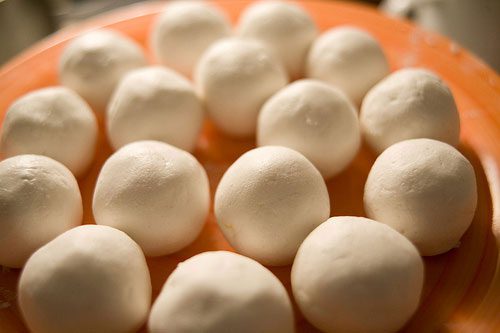
- Divide the dough into equal small portions, appropriate for the amount of filling prepared. Flatten each dough piece, place the filling in the center, fold it over, and roll it into a ball. Make sure to seal it tightly, ensuring no air is trapped inside, as this may cause the dumpling to break while boiling.
Step 4: How to Boil Bánh Trôi and Bánh Chay

Drop the shaped rice cakes into a pot of boiling water and cook until they float and become translucent. Then, scoop them out and place them in a bowl of cold water. After that, use a slotted spoon to transfer them to a plate in an aesthetically pleasing manner, then sprinkle toasted sesame seeds on top of the cakes.
How to Prepare Bánh Chay Syrup
Dissolve the starch with 100g of sugar and water, then place it on the stove to boil until the mixture becomes thick and slightly runny. Turn off the heat and add pomelo flower water for fragrance.
– Serve the Bánh Chay in a bowl, adding the starch syrup. You can also sprinkle some cooked mung beans or shredded coconut (if desired).
You can add pandan leaves, beetroot, or green tea to the dough to create colorful and appealing Bánh Chay.








































